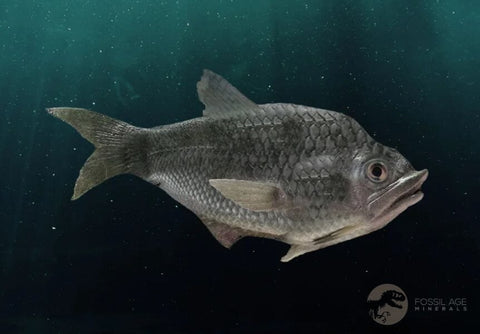XL 5.1" Diplomystus Dentatus Fossil Fish Green River FM WY Eocene Age COA, Stand
Location: Kemmerer, Wyoming
Weight: 2 Pounds 6.8 Ounces
Dimensions: 8 Inches Long, 6.3 Inches Wide, 0.8 Inches Thick (Plate)
Fish Dimensions: 5.1 Inches Long, 2 Inches Wide
Comes with a Free Stand.
Comes with a Certificate of Authenticity.
The item pictured is the one you will receive.
This is a genuine fossil.
56 million years old, Eocene age.
The shape of Diplomystus Dentatus, especially its upward-facing mouth, is characteristic of fish that feed near the water’s surface. This type of fish, related to herrings, probably ate smaller fish living at the surface, as shown by fossils containing Knightia fish in their stomachs or mouths. About fifty million years ago, Fossil Lake covered much of what is now southwest Wyoming. While the lake once stretched up to 930 square miles, about 500 square miles of sediment remain today. The central 230 square miles of this ancient lake bed are rich in fossils and features such as deltas, beaches, springs, and rocks from both central and nearshore environments.
The unique chemistry of Fossil Lake halted decay and scavenging, allowing thin layers of limestone to build up over time. This created laminated limestone formations that hold the world’s richest collection of fossil fish. Alongside diverse aquatic life and striking geological features, Fossil Lake stands unrivaled as the premier Paleogene record of a freshwater lake ecosystem—making this fossil truly exceptional.
Since the discovery in the 1870s, many perfectly preserved fossil fish have been recovered. Preserved with the fish in the laminated limestone is a complete aquatic ecosystem: cyanobacteria, plants, insects, crustaceans (shrimp, crawfish, and ostracods), amphibians (frog and primitive salamander), alligators, turtles, birds, and mammals, including the oldest pantolestid (otter-like animal). The subtropical terrestrial ecosystem surrounding the lake is also represented by rare fossils, including a horse, two snakes, lizards, two bat species, birds, an apatemyid (an arboreal insectivore), a minced (a primitive carnivore), insects, and more than 325 types of leaves, seeds, and flowers.

Please be aware of the nature of fossils:
Being buried under the ground for millions of years under tons of pressure tends to be rough. No fossil comes out of the ground whole and perfect. Most fossils have undergone some restoration, while others are altered by man, simply to enhance their presentation in different ways. These are part of the natural beauty of the fossil and are not considered defects.


















